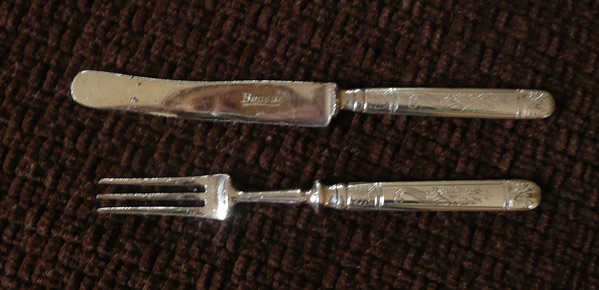Hi Shaun,
I always enjoy your articles. I hope you might be able to tell me something about the child’s knife and fork shown in the attached photos. They have been passed down in my family and I used them as a child. I will be 70 this summer. Can you tell me anything about the set – where made, age, etc. I do not see any marks on them other than the name.
Bonnie

Hello Bonnie,
How well I remember as a child at the dinner table being mildly and repeatedly scolded by my mother: “Don’t eat with your fingers Shaun! Use your knife and fork!” With six children at the table it’s a wonder Mum could keep track of who was using what, but she did!
I am happy to report that my Mum’s admonishments paid dividends and I now only rarely resort to using my fingers at the table. That was roughly 60 years ago and I imagine that a century ago, in the late Victorian period, mothers were saying the same things to their children (although perhaps with more vigour).
Table etiquette has likely been a priority around the world for centuries. Dining in the appropriate manner was important to families and the proper ways of doing so was transferred to children at an early age, especially in Victorian times when touching food with anything but a utensil was a serious breach of etiquette.
The name “Bonsa” on your utensils was the trademark of Bontgen & Sabins of Solingen, Germany, also known as the “city of blades” because of the many manufacturers there that produced knives, swords and other products. Bontgen & Sabins was active from 1867-1983. The company made many products including pocketknives, spring knives, camping knives, straight razors, scissors, as well as edged weapons.
Your little knife and fork was likely made by the company in the 1920’s, possibly earlier, and sold through a fashionable retailer of such items. Since the set lacks any other markings, we may assume that it is made from silver plate. Sterling silver items will feature stamped hallmark symbols that identify its purity as solid silver.
Knives and forks have been in regular use at dining tables since the 16th century. People often carried their knives with them to use with meals. By the early 1700’s people were acquiring sets of silverware to be used in homes, which by that time frequently had dedicated rooms for dining. Silversmiths turned their attention to designing cutlery for this expanding market.
Smaller hands required smaller utensils and silversmiths created cutlery that was smaller in scale but still functional. Sometimes various characters or symbols were included in the design to encourage children to use the cutlery.
Through the course of human history, silver has played second fiddle to gold but it still occupied an important place in society. Owning a case of sterling silver or plated flatware became, and to some extent, still is, a symbol of familial success.
While collecting sterling silver has lost its lustre, it remains a valuable commodity and is treated as such by pickers and dealers who sell it by weight to individuals who, in turn, re-sell it to speciality operators who melt down the sterling silver and also extract the copper used in plated silver objects.
Leaving aside the notion of the value of the metal, small antiques and collectables often have great sentimental value to families and individuals. It is easy to tuck away cutlery, a crib sized quilt or a toy as a remembrance of a child’s progression through early life. As they are passed down in families from one generation to the next, the passage of time further enhances the sentimental value of these objects. In your case, the sentimental value of your cutlery surpasses the market value of the objects.
In today’s highly transient society, jobs, careers, retirement and other factors can uproot families on short notice. Sentimental objects are often the victims of these circumstances. This is especially true of larger items like dining room sets or bedroom furniture.
I encourage individuals to collect smaller-scale antiques like your knife and fork. They can be brought out on occasion to be admired and enjoyed, which, when you think about it, is what all collectables and antiques do for us. They take us back to a different time and place to remind us of what is important, and of the individuals, families and friends who came before us.
Shaun Markey is a resident of Westboro and author of a recently published memoir called Folk Art in the Attic. He also blogs about antiques and folk art at folkartintheattic.blogspot.ca. If you have an antique or collectable and are curious about its past and approximate value, email a photo to shaunmarkey@rogers.com. Please make sure it’s high enough resolution so that details are visible! Any extra information you can share about your treasure is helpful too. Your item – and its story – might just be published in the next column.
